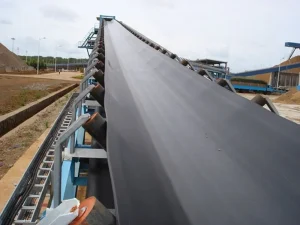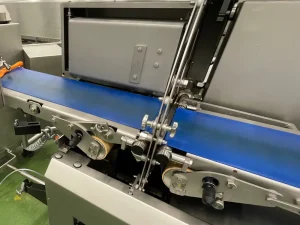How to measure a conveyor belt? This question comes to mind when it comes to replacing the conveyor belts. As you know, conveyor belts of all types have a specific life. The belts move on the rollers. Their consistent movement on rollers causes wear and tear in them. However, selecting a new conveyor belt requires knowledge of belt measurement.
You must choose the right size and dimensions for the conveyor belt. Remember, the wrong-sized belt won’t serve its purpose effectively. Therefore, this article will guide you in measuring the conveyor belt. After reading, you can buy the right size convey belts for your needs. So, let’s get started!
Why Measuring Conveyor Belt is Important?

Knowing how to measure the conveyor belt is essential. It helps you choose the correct belt size with the desired thickness and dimension. Imagine your conveyor belt getting damaged. You go to the market and randomly buy a belt. But it can pose some serious issues. Those include:
- The belt size is too big. It will loose and won’t work effectively. Due to its looseness, it will slip out from the rollers and pulley. This will increase the downtime.
- The second issue is that the belt is getting shorter. Such a smaller belt doesn’t fit on the conveyor system, i.e., the roller and pulley. So, you’ll have to return to the market and change the belt.
- Imagine the belt length you buy is correct. But what if the belt width is shorter or it compromises thickness? With a less wide belt, you can transport fewer items. Similarly, thinner belts pose durability issues. They are more prone to wear and tear (breaking).
Therefore, it is key to learn how to measure belt dimensions. This helps you choose a conveyor belt with the right length, width, thickness, and dimensions. There are two ways to measure belt size. We will discuss both of them in the section below.
How to Measure a Conveyor Belt? Two Methods
There are two scenarios when it comes to conveyor belt measurement. The first is when the conveyor belt is removed and is unusable. The second is when an old conveyor belt is already present and needs replacement. You can replace the old one once it stops working completely.
The conveyor belt measurements in both scenarios are different. We will discuss both methods in the upcoming portion.
Method 1: If the Belt Is Removed or Broken

Let’s discuss measuring the broken conveyor belt. This means the broken belt will be removed from the conveyor system. In such a case, you’ll need measuring tape, ruler, and caliper for accurate measuring. Let’s discuss the process in simple steps.
- First, put the conveyor belt on a flat surface. The belt position should be balanced. If it is unbalanced, the measurement will not be 100% accurate.
- Now, take the measuring tape. Start measuring from one end of the belt to the opposite end. Remember, this measuring must be lengthwise. It will give you the exact length of the belt.
- After that, measure the conveyor belt sideways. Put the tape on one side and measure all the way to the opposite end. Simply put, you’ll have to measure across the belt (from one end to another). This will give you the width of the belt.
- The last step is measuring the thickness of the conveyor belt. As I said earlier, thickness plays a key role in a belt’s performance. I recommend using a caliper when measuring the thickness. The caliper will clamp the belt in its jaws and give an accurate thickness. However, you can also use a ruler if you don’t have a caliper.
I highly recommend double-checking the measurement by repeating the steps mentioned above. This way, you’ll get the right length, width, and thickness. You can note it, go to the shop, and buy the right size belt for your conveyor system.
Method 2: If the Belt Is Still on the Machine

Imagine the second scenario where the belt is not removed from the conveyor system. So, it remains wrapped on the roller, making the measurement challenging. In the section below, I will help you learn to measure the size of the belt in such a situation:
- As you know, the conveyor belt system consists of two pulleys. Generally, the size of one pulley is bigger than the other. The first step is to measure the diameter of each pulley. We used d to denote the diameter of a small pulley and D for a bigger pulley.
- The second step is to measure the straight line distance from the center of the first pulley to the center of another pulley. You can denote this center distance as “C”. Once you have measured these parameters, you can use a simple formula to find the exact size of the conveyor belt used.
The formula used in this measurement is as follows:
L = (D + d / 2) × 3.14 + 2C
In this formula:
L = Length of belt
D = Diameter of bigger pulley
d = Diameter of small pulley
C = Distance between the center of two pulleys
By putting values, you’ll find the exact size of the conveyor belt. For example, assume you measured all the parameters and got follow measurements:
D = 8 inch
d = 6 inch
C = 30 inch
Now, put these values in the formula.
L = (8 + 6 / 2) × 3.14 + 2(30) = 81.9912 inches
So, you’ll need an 82-inch conveyor belt for your conveyor system. This size of belt won’t get loose or too tight. Remember, I just assumed values. However, you will have to calculate the diameter of the pulleys and the central distance between the two pulleys. By putting the value in the formula and using a simple calculator, you’ll get the exact size of belt you’ll need.
Does Wrong-Sized Conveyor Belt Affect Performance?
Yes, conveyor belts of the wrong size reduce the efficiency and increase the downtime.
The belt won’t even fit on the conveyor system if it is small. If it fits, it would be very tight. So, when rollers move, the chances of the belt getting broken are very high. On the flip side, if the belt is too big, it will be very loose on the rollers, so the chances of it slipping out are very high. So, switch on the conveyor system; the belt will fall off.
You’ll have to switch off to reinstall the belt. This will continue, affecting the efficiency of these belts. Even small shop owners may persuade you to buy something slightly bigger or smaller than your desired size. You should never believe them. Why? A slight deviation from the required size will affect the belt’s performance.
Frequently Asked Questions
Can I measure the belt without removing it from the conveyor?
Yes, you can measure whether the belt is removed or not. However, the measurement method is generally different in both cases. So, You should use a pulley method to measure the size of the belt without removing it.
Is the width of the belt important when measuring?
Yes, you should measure the width of the belt. Using the wrong width belt may not fit the conveyor system appropriately. Generally, the belt with a wider width offers more space. So you can transport more items and luggage on such belts.
Conclusion
Conveyor belts help transport goods and other items effortlessly. However, the conveyor belt of every material starts to deteriorate after prolonged use. This is because it continuously rubs on the rollers. Due to this, the wear and tear of this belt is also common. Once the belt is damaged, you’ll have to replace it.
This requires you to measure the size of the belt and then buy a belt of the same dimension. If you don’t know how to measure the size, you’ll buy a belt of the wrong size. Using such a belt will reduce the performance of the conveyor system. In this article, I have discussed two easy methods that will help you find the belt size easily.
